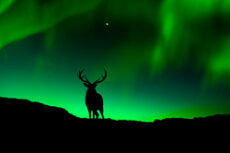
The Aurora Borealis, or Northern Lights, begin their lives on the sun. After severe solar storms, the sun’s surface is showered with electrically charged particles. There are several that head in Earth’s direction. When they do, they are guided to the North and South Poles by the planet’s magnetic fields. The particles hit the upper atmosphere in a ring pattern that revolves around the magnetic poles. Energy is released as light that we can see from Earth in a process that is comparable to what happens inside a fluorescent lamp. The average altitude at which the Northern Lights can be seen is about 100 kilometers.
The Northern Lights, as the name implies, are particularly associated with the arctic regions. The zone with the highest concentration of these events is a 2500 km-wide ring that centers on the magnetic north pole. The so-called auroral zone encompasses much of the northern hemisphere, beginning in the Arctic and extending southward across northern Scandinavia, the island of Iceland, the southern tip of Greenland, and on into northern Canada, Alaska, and the northern coast of Siberia. The coasts of the Norwegian counties of Tromso and Finnmark have the highest occurrence due to their proximity to the Arctic Circle and relatively warm winter climate, making northern Norway an appealing destination for anyone interested in seeing this meteorological phenomenon.